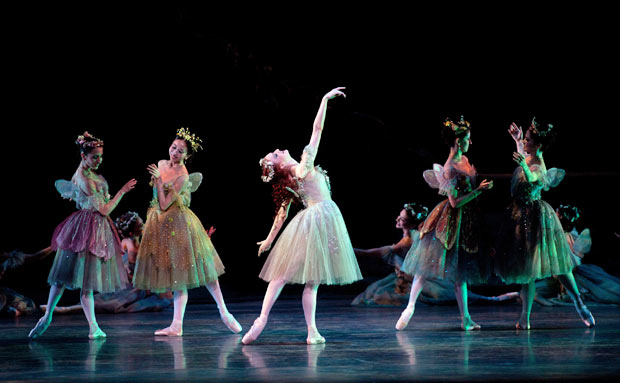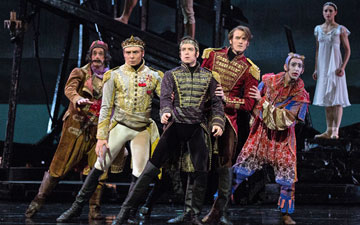
© Rosalie O’Connor. (Click image for larger version)
American Ballet Theatre
The Dream, The Tempest
New York, Metropolitan Opera House
30 June 2014
www.abt.org
Nimble Spirit of Mirth
Who but Frederick Ashton could turn a marital spat into one of the most delightful, touching works in the ballet repertoire? His 1964 The Dream is precisely that: a story of domestic discord that ends in perfect harmony. A husband and wife – fairies, in this case – argue about who gets to look after a little boy. The husband inflicts his revenge by tricking her into falling for an ass (actually a man wearing a donkey head). She spends a night with another man. Coming to their senses, they make up in one of the most blissful pas de deux ever to see the stage, full of shivers of attraction, mirroring arabesques, and in the end, complete erotic acquiescence.
The Dream is the first half of a double-header playing at American Ballet Theatre through July 2. The theme is Shakespeare; the second ballet is Alexei Ratmansky’s The Tempest, created last year. Seeing the two ballets side by side is revealing in a number of ways. One becomes particularly attuned to the complications of staging interweaving multiple story lines, switching between characters and, in the case of The Tempest, hopping between the present and the past. (The Dream manages to do all this quite seamlessly, The Tempest, less so.) One is struck by the extent to which a score can help or hinder storytelling and flow. And one can glimpse common elements, seeing how choreographers learn from each other, while remaining true to themselves.

© Marty Sohl. (Click image for larger version)
If The Dream is a near-perfect ballet, aided by Mendelssohn’s lively, melodic, rhythmically-varied incidental music, Ratmansky’s is a flawed work with passages of great poetry. Ashton’s storytelling rushes breathlessly from the first notes of the overture to the final chord; one barely has time to take it all in. There isn’t a moment in the ballet that isn’t telling the story, with the exception of the fairy dances; there, Ashton tells a different story, about his fascination with nineteenth-century fairy-ballets. In contrast, The Tempest alternates between moments of storytelling – including a beautifully-rendered flashback to Prospero’s betrayal – and passages meant to depict states of mind, a more tricky proposition.
How does one describe the bitterness of exile? Or the self-loathing of the monstrous Caliban, or Ariel’s longing for freedom? At times, Ratmansky succeeds. Ariel’s light, flickering dances – quite Puck-like, in fact – are full of steps in which his feet flutter in the air like hummingbird wings, creating the illusion of never touching the ground. (Daniil Simkin’s dancing has the lightness and effortlessness to sustain this illusion.) When Prospero (danced with earthy gravitas by Marcelo Gomes) forces this airy spirit to acquiesce to his demands, one can feel the chains of duty pulling Ariel down to earth. Caliban’s slithering entrance is suitably revolting, with flopping wrists and fin-like forearms (Shakespeare describes him in fish-like terms). Later, he performs a wild dance, leaping and kicking in the air in twisted, grotesque shapes. But his most compelling scene comes at the end, when, upon realizing he is about to be abandoned, he attempts to imitate his masters, pulling his legs into his version of a balletic fifth position, then crouching to peer at Prospero’s book of charms. (He can’t read, so he rips out the pages instead.) Ratmansky gives him a soul. James Whiteside, unrecognizable in the character’s thick makeup, fright wig, and furry appliqués, manages to express the nobility of the monster’s struggle for human contact.

© Marty Sohl. (Click image for larger version)
Other moments stand out: a chorus of spirits emerging from the waves and crawling forward like an army of lizards; a playful pas de deux for Miranda and Ferdinand, limpidly danced by Sarah Lane and Joseph Gorak (the latter newly promoted to soloist), a stomping, rhythmic folk-dance for Trinculo, one of two comic characters. (These two are reminiscent of the “Rustics” in The Dream.) But the energy of the ballet rises and falls with its score, a suite of incidental music by Jean Sibelius. The pieces are a series of tone poems, marked by vivid orchestral colors: blaring horns, haunting flute melodies, floating strings, with a mezzo-soprano and chorus thrown into the mix. But there’s little rhythmic impulse or momentum to sustain the steps: the music keeps pulling the ballet down, instead of pushing it forward.
Santo Loquasto’s heavy-handed sets and costumes are a further nuisance – Gomes, for example, is barely recognizable in a flower-child wig, headband, beard, and torn shirt. But despite all this there is much to admire here, a depth of imagination and understanding of the characters that keeps one engaged. The Tempest is a noble experiment, if not a completely successful one. In any case, the few judicious cuts that have been made since last season and shorter pauses between sections have helped.

© Gene Schiavone.
There is not much one would change in The Dream. Nor could one hope for a better cast than the one that danced tonight. In Titania, Gillian Murphy finds a role perfectly suited to her strengths: imperious, impetuous, full of whirling turns, petulant kicks, and Alice-in-Wonderland-like tilts of the head. Murphy’s Titania never stops moving, her shoulders fluttering with temper, self-delight, and sensual frisson. Cory Stearns, replacing an injured David Hallberg, uses his majestic carriage, pliant jumps and elegant legato to great effect as Oberon, as well as his elfin and slightly malevolent eyes. As the two lovelorn couples, Adrienne Schulte and Grant DeLong and Stella Abrera and Jared Matthews exhibit great comic timing and just the right touch of cartoonishness. (I particularly enjoyed the reconciliation, when, after shaking hands, the men give each other a very British tap on the shoulder, old chap.)
The Dream with Herman Cornejo as Puck.
But the greatest performance of the night was undeniably Herman Cornejo’s Puck. Cornejo, who has fought against type to become one of the company’s most compelling princes, is simply incomparable here. His soaring jumps, executed with every possible combination of straight and bent legs, seem to pause momentarily in the air, so that the eye registers his pose, as in a photograph. The beats of his feet are crisp, legible, even, at times, audible. And his turns seem to speed up with each revolution, even as his free leg moves from bent to straight, or vice versa. Cornejo’s Puck etches itself in your mind’s eye, a performance to savor and remember. Tonight, he brought the house down.

















You must be logged in to post a comment.